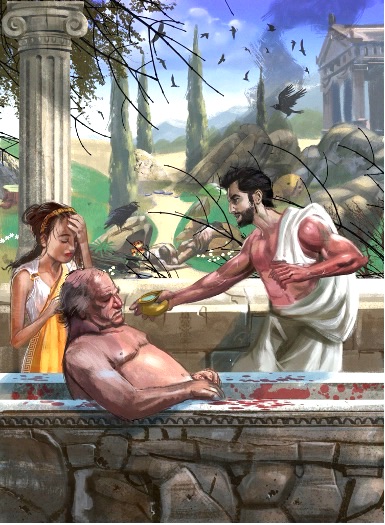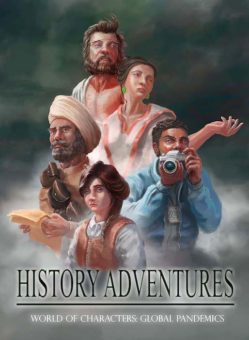Global Pandemics App Shares Fantastic Tales
A MiddleWeb Blog

I compiled a mental list of all the times/places I would visit. My checklist included traveling back 70 million years to catch a glimpse of a T-Rex, making a stop in ancient Rome to watch the gladiators fight in the coliseum, and then voyaging 100 years or so into our future to see if skateboards and cars would actually be able to hover and fly.
As I grew older, my time travel agenda was amended to include events that I hoped to prevent from happening, such as the Holocaust, development of nuclear warfare, and deaths of individuals such as Gandhi, Martin Luther King Jr., and Abraham Lincoln.
Decades later my interest in time travel resurfaced when I was introduced to History Adventures’ Global Pandemics – a fantastic, free Chrome app that transports teachers and students back in time and into the lives, choices, and dilemmas faced by individuals during some of the largest scale plagues and pandemics in history. After several hours of exploring the app (and a visit with its creator), here is what I uncovered.
Interactive History Adventures
Plague of Athens: To Do No Harm is now available to everyone with Chrome browser and is the first of several interactive, digital stories being released over the next six to ten months by Spencer Striker’s design team at Northwestern University in Qatar.

“To Do No Harm” tells the story of Nikos of Athens, a physician during the Athenian plague. Nikos struggles to treat the multitude of people sickened during this world-upending ordeal.
Additionally, the horrific conditions he sees around him cause him to question everything he holds dear including his faith in Apollo (healer under the gods), the meaning of his Hippocratic Oath, and what is truly at stake in medical ethics.
The story unfolds in a choice-based narrative design, much like the choose-your-own adventure books I grew up with. This narrative, however, comes with some real upgrades including…
- 3D motion design and web animation
- vocabulary support
- simulated pathogens
- immersive 360 panoramas of historical locations
- animated historical timelines and maps
- interactive original historical documents
- media-rich adaptive assessments
The experience is cross-curricular, interactive, immersive, and down-right awesome! I would strongly suggest, however, that educators check out the video walk-through on YouTube to get a crash course in order to better navigate the app and to take full advantage of the resources embedded in it.
Where Do You Stand?
When I visited recently online with the creator of these tech-enhanced digital stories, he explained that the design team’s goal is to meld together the very best practices of game-based learning, narrative studies, and multimodal literacies in order to provide students an engaging and challenging learning experience that emphasizes critical thinking.
Each adventure requires learners to study and consider carefully the complex choices that each of us would/must make in the most difficult of circumstances.
I also found out there are several more stories and characters on the way:

►Breath of Life presents the dilemma of Xoquahtli, an Aztec midwife and a priestess devoted to Ichpochtli, the maiden of flowers and goddess of birth. Xoquahtli is living through the devastating smallpox epidemic that had traveled from Europe with the Spanish conquistadors. She must choose whether to stay and oppose the Spanish in the city or to flee to the mountains.
►Red Pepper and Black Pepper tells the story of Achraj, an Indian soldier during WWI, fighting in the British Army on the Western Front. He witnesses the symptoms of the Spanish Flu beginning in the trenches of the Great War and learns that it has already begun to spread to India. Achraj must decide whether to stay and fight for the Crown or return to India to protect his family.
►Positive invites students to consider the story of Brian, a reporter for the San Franciso Chronicle during the outbreak of HIV/AIDs in the 1980s, who is charged by his editor with covering the controversial story. Brian is part of the SF gay community, but in the closet. He must navigate the tensions in society between sensationalism and truth, prejudice and stigma – and decide whether to come out or keep his secret.
Future (and Current) Problem Solvers
For decades I prided myself in my ability to see students’ potential as FUTURE problem-solvers. Recently, however, my purview has expanded as I’ve begun to realize their potential to grapple with the vast number of CURRENT issues and difficulties faced by individuals around the world.
Having spent some significant time with the app, it appears that the creators of the Global Pandemics interactive stories have a similar vision of today’s learners. At the fingertips of every educator is an immersive and engaging tool to help students explore relevant and complex issues, make meaningful connections, and engage in informed decision making.
Note: The Global Pandemics app will work on any device that can use a Chrome browser. It is free and includes no “in-app purchases” or hidden costs. Funding comes from the research university hosting the development team and the plan is to keep it free and accessible to teachers and students.

































